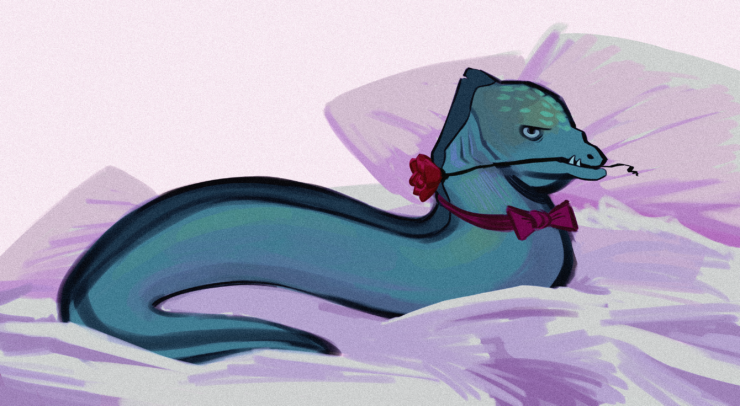EELS
Here’s an incomplete explanation of everything we know about eels, according to the Fulcrum.
Philosophers were very concerned about eels
The idea that eels have sex in the first place is quite new. In the fourth century BCE, Aristotle remarked that fish do lay eggs and breed, but that eels are the exception. They’re neither female nor male and they neither lay eggs or mate. He hypothesized eels are born of mud from dried up ponds and are brought into existence simply by the first rain that falls and fills said pond.
One of Aristotle’s contributions Historia Animalium, marks the first attempt to systematically sort the animal kingdom. Within it, he detailed his scientific discoveries including the hidden insides of the eel, the relative placement of its organs and the construction of its gills. Most notably what’s lacking from his research was any evidence of eel reproductive organs, eggs, or milt (fish sperm).
Apparently, eel reproduction was a heavily discussed topic at the time and Aristotle’s eggless eels sparked great conversation among other philosophers. This, however, was the extent of the conversation and through the centuries many great scientists would try in vain to find the eel’s sexual organs.
Eventually, in 1824, German scientist Martin Rathke would be the first to identify a female eel with fully developed reproductive organs and later eggs. All that remained was the second half of the biological equation, the eel testicles. To my surprise, the next scientist to step up to the plate would be the man, the myth, the legend…Dr. Sigmund Freud.
In search of lost balls, by Marcel Proust Sigmund Freud
This pre-suit-wearing, cigar-smoking, sex and dream-obsessed Sigmund Freud was tasked with dissecting hundreds of eels in search of their balls (excuse me, testes). Just imagine a young 19-year-old Freud in Italy, elbow-deep in eel guts and desperately hoping he’ll find any evidence of a ball sack, so he can prove to himself and the world that he is a serious researcher and biological scientist.
For almost a month this man reeked of dead fish and had examined over 400 eels but sadly not one testicle was found. It’s a little ironic to know that the man who would make his life’s work about human sex and sexuality and could not, where eels were concerned, even locate their sex organs. That had to have changed him in some ways.
A few decades after Freud’s attempt and eventual failure, two scientists by the names of Giovanni Battista Grassi and Salvatore Calandruccio were able to catch larval European eels (Anguilla Anguilla) off the coast of the Mediterranean in 1896, which they would later determine as the birthplace of the eel. What they caught, however, looked nothing like their adult form, but rather appeared more similar to a transparent leaf-shaped creature with tiny heads.
These researchers went on to later observe these larval eels transform into their juvenile stage, more commonly known as glass eels.
A Quick Aside: Black market glass eels
Just as a quick aside, and skipping forward to the early 2010s, glass eels were and still are one of the most expensive fish in the world on a per pound basis, costing more than $2000. They also happen to be highly trafficked by organized crime — these are no ordinary fish, these are black market fish. Why? Well, I’m no economist but I would bet $2000 it has something to do with supply and demand.
To speak to the demand part, glass eels are considered a delicacy in many European countries like Spain, but are also used in Asian cuisine. For example, Japan, which happens to be the world’s top consumer of eels, serves a popular dish known as unagi, grilled eel with cucumber over rice.
For the supply part, it becomes a little tricky because steadily since the early 1980s, the European eel population has been decreasing as a result of overfishing. Since so little is known about eel mating, they cannot be bred in captivity or factory-farmed in the traditional sense; this adds fire to the flames, so to speak. All of this has resulted in a perfect storm of high demand, but low supply and really no means of understanding how to breed more.
Circling back to the black market, the business of catching and selling glass eels became so lucrative and profitable that some dealers were buying glass eels from places where it was illegal to fish them. They trucked them to destinations where they could be mixed with legal eels, doctoring shipping dossiers, and exporting them to Asia.
Interviews published by National Geographic detailed how one American fisher in particular, “hired a bodyguard…who keeps a Glock visible in his holster at all times to protect against thieves. Most other [fishers] armed up too.”
Turf wars broke out between fishers, robberies and fist fights were a common occurrence. Put simply, these were the early days of the eel fishing gold rush.
Around this time the Atlantic States Marine Fisheries Commission was clamping down on the amount of eels that could be caught and sold. The federal government also launched an investigation named ‘Operation Broken Glass’ — which continues to operate to this day.
Back to in search of lost balls eels
Returning now to the groundbreaking discovery of eel larva, which caught the attention of many. One of whom was Johannes Schmidt, a biologist from Denmark, who was left unsatisfied with the determination of what was scooped up on those beaches.
Instead, he believed those were not the earliest life stage of an eel since they were three to four inches long and were obviously not newly hatched. He was thus determined to find the actual birthplace of the eel and their true larval form.
Schmidt would dedicate 20 years of his life patiently sailing up and down the coasts of Europe and eventually out into the open ocean collecting smaller and smaller eel larvae, finding himself being pushed farther and farther west. Finally in 1923, he found his smallest one yet on the southern edge of the Sargasso Sea, which is northeast of the Caribbean and to the southeast of Bermuda.
Armed with this new knowledge of understanding where eels come from, we must’ve been able to observe them mating, right?
Apparently not, since to this day we have never found adult eels or their eggs there and we don’t know how the adults got there. This left us stuck with indirect evidence for where eels come from up until late 2016 when a team of researchers finally published how they tracked adult eels back to their breeding ground.
Only then could we conclusively state European eels are catadromous fish, which means they spend most of their lives in freshwater environments before returning to the ocean to breed as their adult form (known as silver eels at this point).
There was honestly a bit of a lull in research after Schmidt — hard to follow the guy who sailed across the ocean for 20 years. However, eventually, during the 1980s, marine biologist James McCleave and Gail Wippelhauser would pick up the torch. They had a devious plan to lure the eels out from the depths where they bred.
The plan was as follows, step one: catch 100 adult female eels, inject them with hormones and induce sexual maturity. Great, step two: use said females as bait to attract males to the surface. Step three: watch the eels boink.
However, this plan did not work. As it turns out, female eels who are sexually mature are also pretty close to death, so a big chunk (95) of those 100 eels died before they even reached the Sargasso Sea. Secondly, it seems the male eels were rather unimpressed with the five remaining females presented because not one male showed up. I guess they didn’t want to mate in cages in front of two random people — fair enough.
Where does that leave us? Well, we can go back to 1973 when Japanese scientists actually managed to catch sexually mature eels; one male and two females. If we learned anything from the last guys though, they would’ve anticipated the females dying pretty shortly after capture.
However, they did not die in vain. Researchers were able to extract the eggs from the female and inseminate them artificially. If we can’t watch them mate in the wild we can at least watch their development in a lab setting right? Please tell me I’m right.
Nope! The transparent leaf-shaped larva kept dying. Why? They simply refused to eat. Are you kidding me? No really, these researchers could not figure out what these newly hatched eels wanted to eat. They tried a whole range of foods, plankton, roe, octopus, jellyfish, shrimp, rotifers, nothing worked. Imagine dying simply because you’re a picky eater.
It wasn’t until 2001 (30 years later) when they finally learned these larvae would accept a plate of powder made of freeze-dried shark eggs.
I want to say things went better from here, but it didn’t. Although they had successfully gotten them to eat and transform into their glass eel stage, it wouldn’t be until 2010 that the scientists succeeded for the first time in completing the life cycle of the eels.
The eels were given hormones to make them grow faster, which lead to severe deformities in their offspring: leaf shaped larva that didn’t look anything like the ones caught in the sea, their heads strangely misshapen, and the animals themselves unable to swim.
To quote Patrik Svensson, a fellow eel enthusiast, “it was as though the eel[s] were refusing to let anyone else control its creation. As though its existence was its own business.”
And that’s the most recent findings to date, that’s it folks that’s all she wrote.






